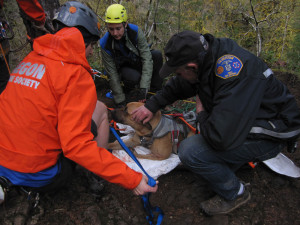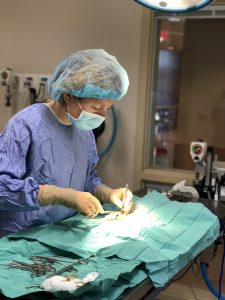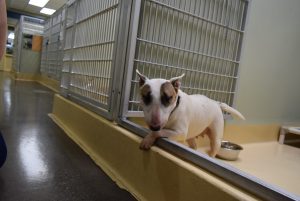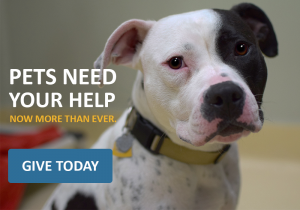
Oregon Humane Society responds to one of the biggest crises in the organization’s 152-year history
Less than six weeks ago, our community was turned upside down as COVID-19 became a major emergency. With extensive experience in disaster response, Oregon Humane Society quickly assembled a team of FEMA-trained staff to manage the challenges the pandemic posed to shelter operations. And with the news changing almost daily, OHS has been prepared and flexible to meet the needs of staff, shelter pets and the community.
Leadership is critical in emergency response. During the recent pandemic, OHS Chief Operating Officer Brian August has led the team in his role as Incident Commander. The group meets daily to review the latest recommendations from health officials, assess challenges and prepare contingency plans.
This Q&A with Brian August provides an inside look at OHS’ response to the pandemic.
How was OHS prepared for this current crisis?
 Brian August: Over the last several years, OHS has been one of the leading animal-welfare responders to natural and man-made disasters. This experience has helped OHS have a staff of highly-trained and capable responders.
Brian August: Over the last several years, OHS has been one of the leading animal-welfare responders to natural and man-made disasters. This experience has helped OHS have a staff of highly-trained and capable responders.
In June 2019, OHS formalized our emergency response structure when we prevented an outbreak of dog flu after we learned a dog who had been transported to us was exposed to the virus.
With our learnings from that situation, we established an incident command system (ICS), based on FEMA protocols.
Using the ICS structure we were able to effectively plan and respond to the changing situation with COVID-19 while keeping staff informed and engaged.
What were the first few weeks like?
They were more organized than you would expect. Within days of Oregon having its first case, we came together to plan our response and ensure effective communication. We often met more than once a day to discuss the latest information and make the best decisions to keep staff and volunteers safe. We also kept the OHS board informed so they fully understood our response and the impact of this crisis.
Who is still physically at the shelter?
Key personnel remain at the shelter, including critical medical staff, foster, admissions, animal care, customer care and facilities. The business office continues to come in as needed to pay bills and process checks.
What programs will be affected most by COVID-19?
 Because of the pause on elective surgeries, Spay & Save (our low cost spay and neuter program) will see the most change. This crisis will result in a reduction in the number of pets spayed/neutered in our community. We will need to have an increased focus on catching up once external conditions normalize. I anticipate a renewed focus on our Second Chance program once we are able to help shelters that have been limited by the current crisis.
Because of the pause on elective surgeries, Spay & Save (our low cost spay and neuter program) will see the most change. This crisis will result in a reduction in the number of pets spayed/neutered in our community. We will need to have an increased focus on catching up once external conditions normalize. I anticipate a renewed focus on our Second Chance program once we are able to help shelters that have been limited by the current crisis.
I also anticipate that many communities will have a very busy kitten season so the demand for transports will be even higher.
Long term, some of the changes we have made to accommodate social distancing, like telehealth for our pets in foster care, could carry forward. Some of the operational improvements might change how things run in the future.
Do you have an idea of what the consequences will be for suspending Spay & Save operations?
I think the biggest concern is that we will have an extremely busy kitten season starting at the end of April. The difference will be in the number of cats and kitten locally versus being able to help other areas. It will be a step back, but it won’t undo a decade of progress. Because we expect this issue to materialize in the next few weeks, we have already started to plan for it.
Are the animals who were sent to foster being made available for adoption? How are they being prioritized?
They are being made available for adoption as quickly as possible based on their medical or behavioral needs. We’ve seen such a strong demand for adoptions that we have adjusted some of our processes. When we talk to potential adopters and try to find a good fit, we also discuss the pets in foster who are ready to come back. If there is a good match, we are able to bring that pet back to meet with potential adopters.
Is OHS seeing an increase in owner surrenders currently, or an increase in surrender requests?
We have not seen an increase in people needing to relinquish their pets, but we have accepted a number of emergency surrenders. Unique to this current situation, we have had a few emergency boarding requests from people struggling with COVID-19 related issues.
Do you expect more surrenders after COVID-19?
Personally, I don’t think so. The way we view animals is that they are integral members of our family and giving them up is an absolute last resort. Most people will do anything for their pets, so we expect that we will get far more requests for help than owner surrenders.
Are you worried that people will bring pets they adopted back after the crisis?
I’m not worried about that. With adoptions by appointment, our staff is doing a great job of finding the right match for the right person. Right now, more than 95 percent of people who come in to meet a pet end up adopting.
How do you expect operations will change after this crisis? (For example, will adoptions by appointment or something similar continue?)
I think the need for some physical distancing will persist after the crisis. Things will look different than the crowded, packed lobby we’ve had in the past. All businesses will need to figure out what people are going to be able to live with.
Are the animals calmer without so much foot traffic in the shelter?
 Definitely – less activity has reduced the stress level among most of the animals. It’s been especially helpful for the pets in our Behavior Modification Program (B-Mod). That is one bright spot in all this.
Definitely – less activity has reduced the stress level among most of the animals. It’s been especially helpful for the pets in our Behavior Modification Program (B-Mod). That is one bright spot in all this.
How is OHS planning for potential future issues? (For example, increased owner surrendered pets, more puppies and kittens due to stopping spay and neuters, decrease in donations etc.)
We are planning for a variety of contingencies based on the understanding that the return to a new normal will likely be gradual. For example, we want to get spay/neuter back on track as soon as possible so we can help other shelters. A big question for me is, “What does social distancing look like moving forward and how do we adjust operations?”
How is OHS mitigating future issues? (For example, the need for pets’ food, emergency sheltering for owned pets etc.)
We are coordinating with community partners to understand the demand they are seeing. It’s important that we work with our partners, like Multnomah County Animal Services, across the region so we are all in alignment.
What are the biggest challenges OHS is facing right now?
 Our biggest challenge right now is making sure we are able to continue our critical, life-saving work while protecting the health and well-being of our staff, the animals and the public.
Our biggest challenge right now is making sure we are able to continue our critical, life-saving work while protecting the health and well-being of our staff, the animals and the public.
Another big concern is ensuring we have the resources necessary to resume work that we had to suspend due to the COVID-19 outbreak. Right now, fundraising is critical to resume those operations as quickly as possible. Here are the best ways you can support OHS right now.
What are the biggest challenges OHS will be facing in the future?
Retaining our staff, re-engaging our in-shelter volunteers and accelerating the impact we have on the animal welfare community are going to be more important than ever.
OHS has been on the forefront of animal welfare for decades and our leadership across the country is needed now more than ever. Our ability to navigate challenges, innovate and overcome roadblocks will be helpful to organizations across the country facing similar challenges.
What has been your biggest challenge as OHS’ Incident Commander during this crisis?
The biggest challenge in this role is making sure that people have the right resources and information to keep everyone safe.
Part of my job is to also keep everyone focused on the task at hand. Making quick decisions can be challenging when there is conflicting information from trusted sources.
The initial response is much more about contingency planning and changing course many times a day. Now we are in a new phase of relative stability where we plan for what could happen next.
It’s also very important that I make sure leaders who are part of the response to this crisis are taking time for self-care so they are able to respond to the next wave of changes.
I am so impressed with the way OHS has responded. Every person has really stepped up to the challenges we have been facing. I can’t imagine a better team to respond to this crisis and it makes me extremely proud to be a part of the OHS family.
For the latest updates on our COVID-19 response and ways you can help, visit oregonhumane.org/coronavirus.






